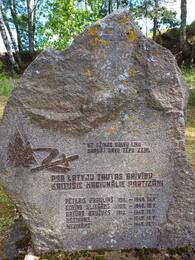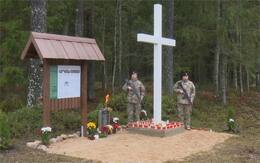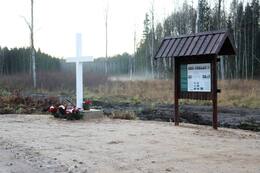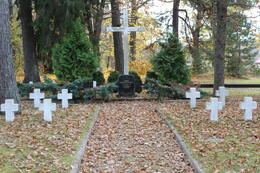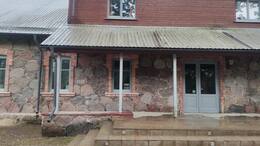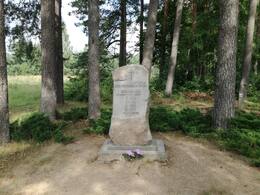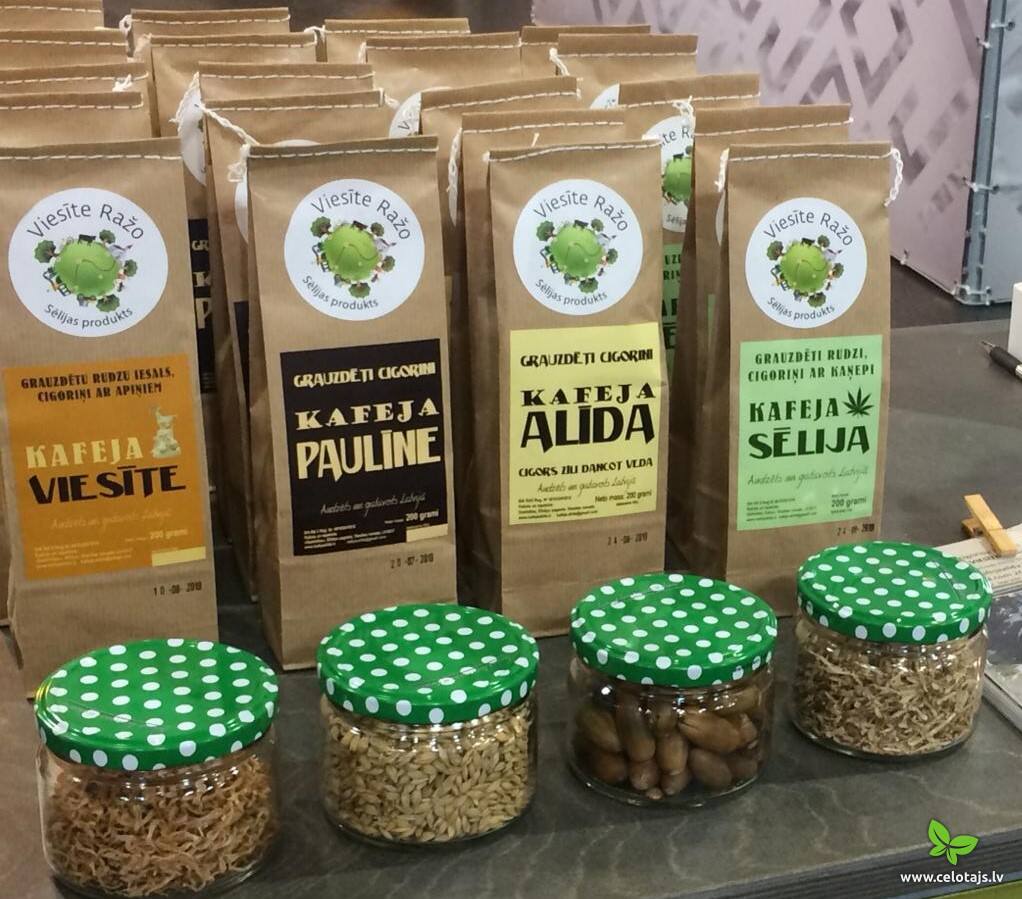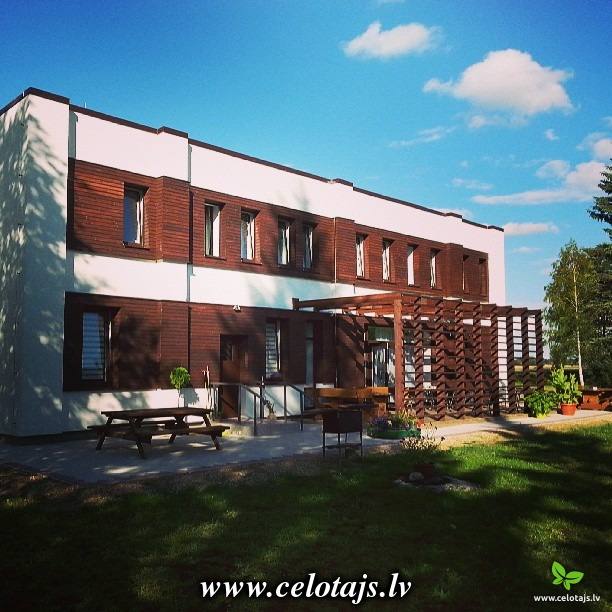Ginkluotas pasipriešinimas sovietų okupacijai Sėloje
Diena 1.
48 km
Kalna pagasts - Aknīste - Susēja
Praktinė informacija
* Braukšanas attālums: ~48 km. Liela daļa autoceļu ir asfaltēti, taču nokļūšana līdz nomaļākiem objektiem var būt pa ceļiem ar grants segumu.
* Maršrutā ir ļoti maz vietu, kur ieturēt pusdienas un vakariņas. Maltīti var pasūtīt iepriekš vai var ņemt līdzi savu ēdienu pusdienām.
* Bijušo Susējas pagastmāju var apskatīt iepriekš piesakoties. SUSĒJA darbojas kā mākslas rezidence, kur reizi gadā notiek festivāls “Sansusī”.
* Piemiņas vietas var apskatīt jebkurā laikā
* LIEPAS piedāvā tikai banketu servisu un naktsmītni, kā ikdienas kafejnīca nedarbojas.
Lankytinos vietos
Memorial place for the members of P. Prauliņas national partisan group in Vidsala
The group of national partisans of Pētera Prauliņa (1911-1949) of Biržu parish was part of the group led by Mārtiņas Pokļevińskas (1902-1951). The group carried out several partisan actions in which they punished Soviet collaborators and requisitioned food and property of the economic institutions of the occupying power. The partisans of P. Prauliņa's group did not observe sufficient conspiracy, many persons visited their settlement, which created an opportunity for betrayal. Lack of military experience was one of the weaknesses of the guerrilla armed movement.
P. Prauliņa's partisan group was destroyed on May 16, 1949 in the Kalna forest of Biržu parish during the operation of the Ministry of State Security of the LPSR, in which military units also participated. The Forest Brothers had created a bunker with circle defenses, well camouflaged and located at an indeterminate height in a swampy area. The partisans fiercely resisted the Czech army units for at least 40 minutes, but the entire composition of the group fell: Pēteris Prauliņš, Artūrs Bružuks, Jānis Kalvāns, Edvīns Slikšāns and Francis Skromanis. The forest brothers who were shot were dumped near the parish house, but their remains were later buried in nearby gravel pits. Irma Bružuk was seriously wounded, who was captured and died on May 17 in Jēkabpils hospital. She was buried outside the cemetery, but when the cemetery was expanded after the restoration of Latvia's independence, a monument was placed on her grave.
The memorial stone for the partisans of P. Prauliņa's group in Kalna parish was consecrated in November 1998. The place of P. Prauliņa's bunker is located in the 4th district of the 99th block of Vidsalas, Kalna parish. The stone on which P. Prauliņš sat has been preserved.
Memorial place for members of J. Indan - J. Gravelson and M. Poklevinska national partisan groups
Informative stand and memorial place for Indān - Gravelson's national partisan group in Kalna parish of Jēkabpils county, in the vicinity of Sūpes purva, opened on Lāčpleš day - November 11, 2019. Its opening was attended by representatives of Jēkabpils and Viesītes counties, former national partisan H. Miezīte, historian H. Bruņinieks, as well as guests from Lithuania and other interested parties. The memorial site and the stand are located by the Sūpe swamp, which is connected to the places of settlements and battles of the national partisans. Deeper in the forest was also the bunker of the Indan-Gravelson group.
After the deportations of Latvian residents on March 25, 1949, the supply system of the national partisans was destroyed. From the summer of 1949 to the middle of 1952, the national partisan movement in the vicinity of Aknīste, Sauka, Elkšť, Birži and Viesīte experienced its decline, as it suffered from ethnic cleansing and regular countermeasures by the Soviet army and security authorities. The settlement of the group of national partisans of Jānis Indāns and Jānis Gravelsons in the Elkšņu forest, 1949-1950. during the winter period of 2010, there was a very serious defense system, uncharacteristic of that time, which did not exist anywhere else in Latvia or in its neighboring country, Lithuania, in the 1950s. The bunker of the Indan-Gravelson group had specially designed circular defense trenches and gun emplacements. Along with the military readiness of the partisans to sacrifice their lives in the fight against the enemy, it is also possible to talk about their special identity, which was also manifested in the involvement of the other family members in the ranks of the national partisans.
12 people worked in the joint partisan group of Indāns-Grāvelsons, including five women and one Lithuanian partisan: Jānis Indāns, Jānis Edvards Grāvelsons, Alma Gravelsone, Pēteris Indāns, Kristīne Indāne, Milda Ārija Indāne, Vasilijs Sokolovs, Voldemārs Otto Sātnieks, Jānis Ķepiņš, Hilda Deputy, Artūrs Snikus, Jons Žukauskis. Their last battle took place on February 25, 1950 in the Elkšņu forest, when 11 partisans fell in the fight against disproportionate numbers. Only Hilda Vietniece (Miezite) survived, who was captured and later spent six years imprisoned in Gulag camps.
Memorial site at the site of the battle of the national partisans on February 13, 1945 in Dimantu Meze, Kalna Parish
The memorial site has been created by the regional highway P74 Siliņi - Aknīste, 12 kilometers from Aknīste turning to the Latvian national forest "Žagaru road".
At the end of the summer of 1944, the vast forest massif of the northern part of Elkšť parish became a gathering place for people who were preparing for an armed struggle against the Soviet occupation. At the end of 1944, groups of national partisans began to form around Aknīste. A suitable place for the establishment of a partisan camp was the Dimantu mež , which was located on the southern edge of the large Elkšņi forest, near Aknīste Great Marsh. There, less than 10 kilometers from Aknīste parish, the national partisans created three winter bunkers for wintering. The connections of the men gathered in the forest were ensured with the support of the residents, neighbors and partisans of the nearby houses - Baltimore, Gargrode, Lichi, Priede, Krumi and other houses.
The partisan battle with the soldiers of the State Security Ministry of the LPSR took place in the Diamond Forest on February 13, 1945. The Chekists, having captured the hostages, drove them forward to show them the partisan bunkers. The forest brothers, seeing the danger, opened fire without sparing the hostages. 10 representatives of the Soviet occupation troops, eight national partisans and four hostages died in the battle. Despite the losses of the forest brothers, the Chekists failed to capture the partisan bunkers. The surviving partisans waited for darkness and left the settlement. Czech soldiers wounded in the battle could not leave the kingdom, moaning. After this battle, which can be considered the first "baptism of the forest brothers", the partisans felt like brothers and the rifle seemed more precious than anything else, as the only reliable savior.
The white cross and the information stand were installed in the Diamond Forest on Lāčpleš Day - November 11, 2022. The creation of the memorial has been supported by the municipality of Jēkabpils region, the association "Tēvzemes sargi" and Latvian state forests. The author of the content part of the informative stand is historian Haralds Bruņinieks.
Cemetery of the Brothers of the National Partisans of Selia
The graves of the brothers of the national partisans of Selia were opened on October 30, 2004 with the support of the Ministry of Defense of Latvia and Aknīste municipality. Partisans Alberts Karankevičs (1914-1949), Vilis Tunķels (1911-1949), Arnolds Tunķels (1926-1949), Osvalds Tunķels (1929-1949), Ēvalds Kundzāns ( 1927-1949).
partisans Juris Alfreds Voldemārs Lācis (1908-1945), Eduards Kaminskis (1910-1945), Osvalds Mežaraups (1911-1945), Alberts Mežaraups (1915-1945), Antons Bružiks (1911-1945), Jānis Britāns (1926-1945) and one unknown. Marta Mežaraupe (1907-1945), Alberts Lācis (1902-1945), Juris Resnītis (1901-1945) and Pēteris Bite (1907-1945), as well as the groups of Indān-Grāvelsons, who fell during the battle and were taken hostage by the Soviet occupation authorities, are also buried in the common cemetery. fallen partisan Voldemārs Otto Sātnieks (1911-1950). There is also a monument to Alfred Silaraup (1925-1946), a national partisan of the Aknīste company, who fell during a check operation on July 30, 1946, on a narrow-gauge railway in the Elkšņu forest.
A black granite stele with the emblem of the National Partisans Association of Latvia is placed at the foot of the White Cross installed in the cemeteries of the Brothers of the National Partisans of Selia and the text "For the national partisans of Selia. You sacrificed your lives for Latvia in the fight against the communist occupation regime in 1944-1954." There is also a memorial stone in the grave area with the inscription "There are tears that will be done in silence." There are scars that won't heal if healed", which Stanislav Šadurska installed at the beginning of the Awakening at the pit where the Chekists buried the national partisans and hostages who had fallen the day before on February 14, 1955.
The former Susėja Parish Hall, the site of an attack by national partisans on July 7, 1945
Today, the building of the former Susėja Parish Hall houses the Sansusī Residence Center and the guest house "Susēja". On the facade of the building you can still see the traces of the attack, left by the bullets fired during the attack of the national partisans on July 7, 1945.
The former Susėja Parish Hall, which at that time functioned as the local executive committee of the Soviet occupation power, suffered an attack by the Selia national partisans on July 7, 1945. The attack on the executive committee of Susėja was a part of a wider action by national partisans and took place simultaneously with the attacks on the Vilkupe dairy and the house of the exterminator Kaunacka.
According to the instructions of Albert Kaminsky (1920-1946), the commander of the national partisan group of Suseya, the forest brothers were supposed to destroy the security of the local executive committee, take weapons, militia uniforms, documents and destroy telephone communications. About 17 Lithuanian partisans of the forest brothers participated in the attack on the Susėja executive committee under the leadership of Jozos Kuveikais. The battle lasted 15-20 minutes, one Lithuanian partisan fell during the shooting, and on the opposite side - fighter battalion fighter Jānis Kakarāns. During the shooting, the windows of the executive committee were broken and the telephone was damaged.
The second attack on the executive committee of Suseia took place on July 16, 1945, when a longer firefight took place between the forest brothers and fighters of the fighter battalion who sought refuge in the executive committee building. During the battle, a group of Soviet soldiers came to the aid of the latter, who opened machine-gun fire from the flank and forced the partisans to retreat. At least five forest brothers and five destroyers fell in the battle. Attacks on this administrative object of the occupying power proved the nature of the armed resistance of the guerrilla war and were a warning of the people's resistance to the Soviet occupation power.
Monument to the national partisans of Susea
The unit of national partisans of Susea was formed from smaller, fragmented groups of forest brothers, because initially there was a lack of a leader who could unite them. Artūrs Grābeklis, later Markeis Gorovņov, who died in the winter of 1945, tried to coordinate the activity of Susėya partisans for a short time. The strengthening of the national partisan unit of Suseia took place after the arrival of the former legionnaire Alberts Kaminskis in Selia after the general capitulation of Germany in Kurzeme. He established stricter discipline and united smaller groups for a common struggle against the Soviet occupation. Cooperation was also formed with groups of forest brothers from nearby parishes and surroundings, especially with the Gārsene group and Lithuanian partisans who had settled on the border between Lithuania and Latvia.
In the early stages of the armed movement, it can be seen that the forest brothers were not prepared for attacks, unable to occupy the Kaunacka homestead, nor to break into the building of the executive committee of Susėja. The partisans suffered losses and were not able to resist the Czech troops for a long time, and the main method of fighting was to think about retreating in time. There was also a problem with the supply of the partisans. In spite of the difficulties, the national partisan unit of Susa was still able to actively resist the Soviet occupation in the first post-war years. This partisan group ceased to exist after the death of its commander A. Kaminsky on May 14, 1946. This was followed by the legalization of several forest brothers, as well as the joining of other guerrilla groups.
The monument to the national partisans of the Suseia detachment was opened on November 11, 1997, following the initiative of the researcher of the history of the national partisans of Selia, Gunārs Blūzma. Next to the words of the fallen national partisans of Susėja, the text: "On the head of a hedgehog, protect the land of your fathers" is engraved in a rough-hewn boulder under the sign of the cross. The memorial mentions those who died in the attack on the Susės executive committee on July 16, 1945 - Jānis Grābeklis (1923-1945), Ādolfs Rācenis (1919-1945), Bronīslavs-Arvīds Bīriņš (1919-1945) and Edgars Ārglis (1920-1945), later added the murdered Names of Lina Kaminska (1917-1945) and Albert Kaminska (1920-1946). Arnold Dombrovskis (1923-1945) and other national partisan groups of Susėja in 1945-1946 are missing from the monument. the names of active and fallen national partisans.
****************************************************
Lauku ceļotāja tūrisma maršruts pa Sēliju piedāvā detalizētu apkopojumu ar papildu apskates vietām:
https://site-244605.mozfiles.com/files/244605/Selija-LAT-3.pdf
Vietos pavalgyti
Kafeja Alīda
Aromatic coffee is produced here from chicory and on the basis of ancient recipes from grandma Alīda. All of the ingredients come from surrounding fields and forests. Roasted chicory coffee PAULĪNE (rye, chicory, carrots, acorns); roasted rye, chicory, and hemp coffee SĒLIJA (rye, chicory, carrots, hemp leaves); rye malt, chicory, and hop coffee VIESĪTE (rye malt grains, chicory, hops). Produce can be purchased.The owner will offer you a tour, during which you will be able to taste and buy her coffee.
Kafejnīca “Kalniņā” piedāvā augstas kvalitātes maltītes, uzkodas, dažādus dzērienus un kokteiļus.
Pieejama gan bistro veida bufete, gan jau sakombinētas porcijas.
Iepriekš piesakot, tiek nodrošināta arī grupu ēdināšana.
https://visit.jekabpils.lv/lv/objekti/paliec/edinasana/vieta/kafejnica-kalnina-akniste/
https://www.facebook.com/kafejnicakalnina
Vietos apsistoti
LIEPAS
Guest house Liepas offers four rooms - two comfort (with WC, shower, TV), two with shared WC and shower. There is a spacious balcony, lobby with seating area, TV, Novus table, 24/7 Tea table. Catering in the ground floor cafe. Please arrange breakfast and dinner at the time of booking.
Gārsenes pils hostelis piedāvā nakšņot gan gultās, gan uz matračiem, arī istabiņu ietilpība ir ļoti dažāda - gan divvietīgas, gan četrvietīgas, sešvietīgas utt.
Kopā vienlaicīgi pils spēj nodrošināt nakšņošanu 45 viesiem gultās un 37 viesiem uz matračiem.
Visiem nakšņotājiem ir iespēja izmantot koplietojamās dušas, labierīcības un virtuvīti. Pils parkā ir iespējams nakšņot teltīs.
http://www.garsenespils.lv/naksnosana/
***
Atpūtas komplekss “Kalniņā” piedāvā plašu viesmīlības pakalpojumu klāstu: viesnīcu, kafejnīcu, mūsdienīgu SPA kompleksu un sporta zāli. Te ir arī plaša āra atpūtas bāze ar teju hektāru lielu dīķi, kas atrodas gleznainā, pakalnu ieskautā vietā.
Viesnīcā ar septiņām guļamistabām kopā ir 32 gultasvietas.
https://visit.jekabpils.lv/lv/objekti/paliec/naktsmitnes/vieta/atputas-komplekss-kalnina-/




